
Pest: White mold (Sclerotinia sclerotium)
Pest/disease lifecycle, most common damage symptoms and crops affected:
White mold (Sclerotinia sclerotium) is a widespread disease of over 300 species of plants. It is only a sporadic problem in “normal” and dry growing seasons; however, white mold can be very damaging in wet years and, if it goes unrecognized or is not well-managed, it can continue to be problematic in following seasons, regardless of weather. Understanding the disease organism’s lifecycle is critical to successfully managing it.
White mold infections can occur in most, if not all, vegetable crops, but damage is most commonly noted on lettuces, green beans, cucurbits, brassicas, carrots, potatoes and tomatoes, especially when grown in higher-humidity environments like high tunnels and greenhouses (fig. 1-3). A related species, Sclerotinia minor, causes “lettuce drop” in lettuce, and organic management considerations are similar.
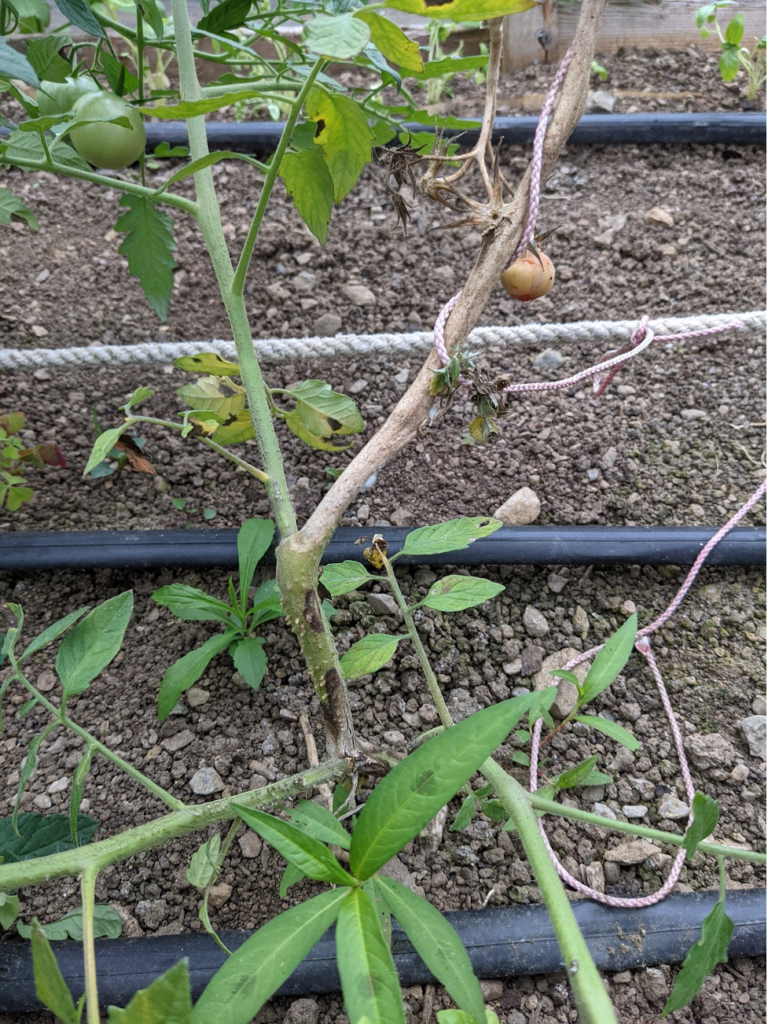
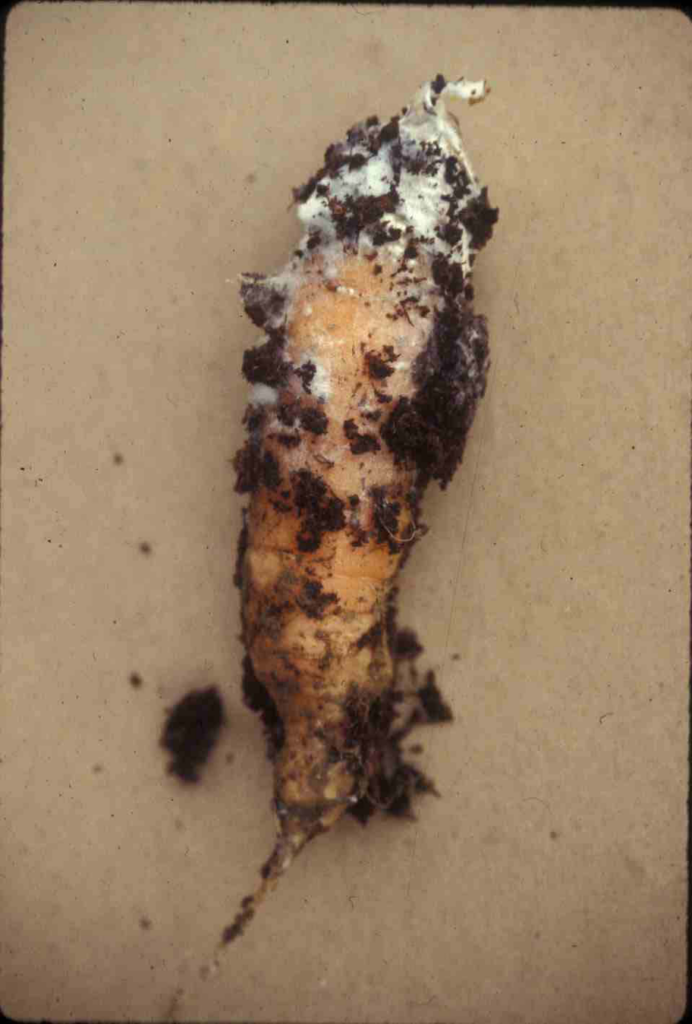
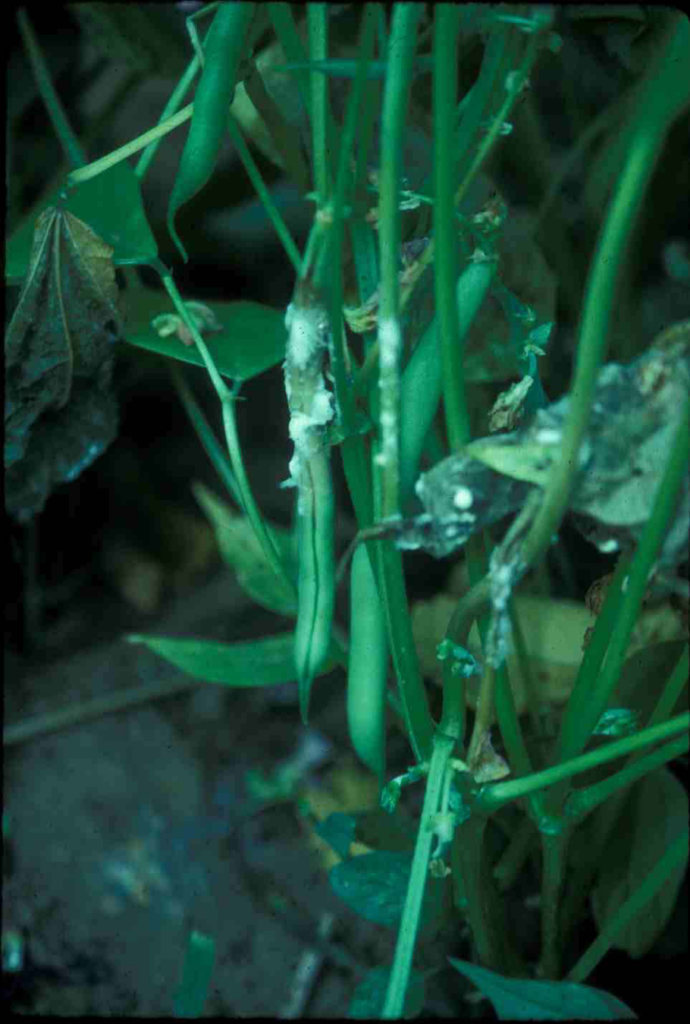
White mold overwinters as sclerotia — dark, hardened masses of mycelium, said to resemble rat droppings (fig. 4), which are very tough and can survive in the soil for five to eight years. In the spring and early summer, overwintered sclerotia in the top 2-4 inches of soil are triggered to germinate in moist soil as temperatures reach the 50s (F). Sclerotia will not germinate, however, unless they have been stratified (undergone a prolonged moist cold period in temperatures below 40 F).
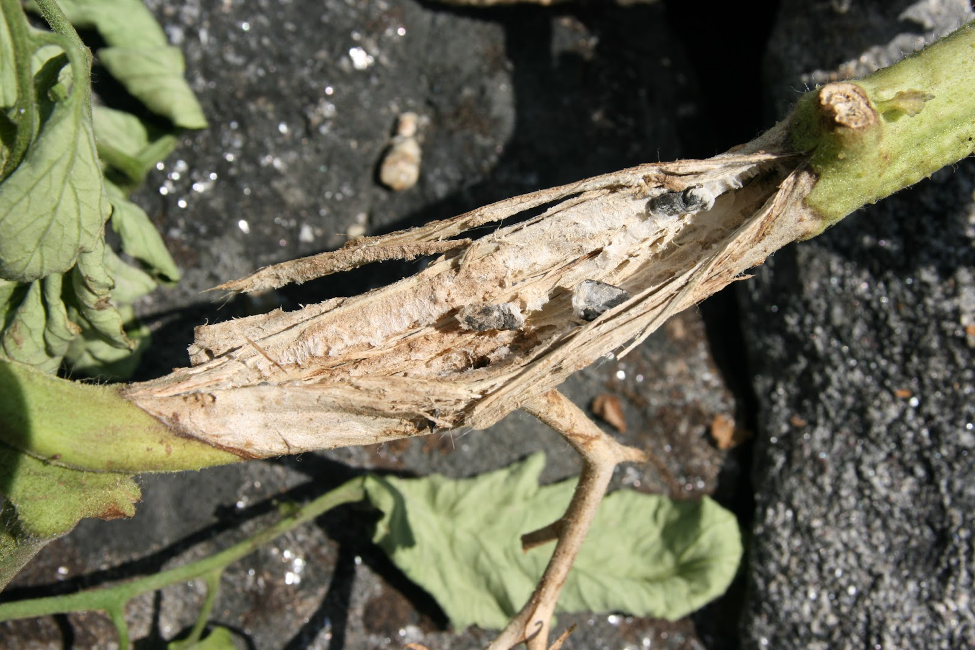
Germinated sclerotia in the top 4 inches of soil produce mycelium, which may infect nearby plants directly. This is the primary pathway of initial infections in the earlier part of the season. When soil remains cool and very wet, sclerotia also produce a mushroom-like fruiting body at the soil surface, called an apothecia (fig. 5), which releases thousands of airborne spores, called ascospores. Apothecia are most likely to be formed after the plant canopy closes, creating humid conditions that favor spore survival. The majority of apothecia grow from sclerotia in the top 1 inch of soil. If these spores land on a plant under appropriate environmental conditions, they can infect the plant.
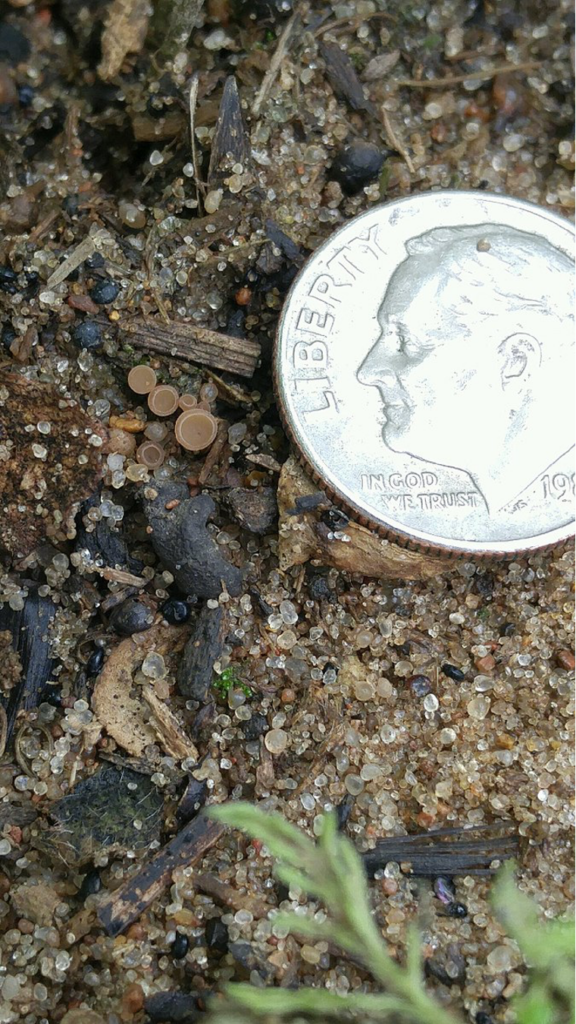
Airborne spores require injured or dead tissue as a food source to initiate infection of healthy plant tissue. This can be as minimal as a fallen flower petal, or a leaf that has dead leaf margins. Successful germination of airborne spores is favored by relatively long periods of wetness (16 to 72 hours) and moderate temperatures (68 to 77 F). These conditions produce the most rapid development of disease, and white mold infection severity is greatly reduced in very hot weather. Because of these requirements, white mold infections often start on crop debris, such as fallen flower petals, that have landed in spots that also tend to collect moisture, such as leaf axils (where leaf meets stem) or stem joints (fig. 1).
Initial infection may show up as a small, circular, water-soaked lesion, but it typically grows in size rapidly. Dead infected plant tissue may take on a dry, bleached papery look (called “timber rot” in solanaceous crops like tomatoes, fig. 1, 4), and may create a lot of white fuzzy mycelial growth in wet and humid conditions (from which the disease’s common name derives, fig. 2, 3).
Importantly, an infected plant does not produce airborne spores that can infect other plants. An infection may spread from one plant to a neighboring plant in humid conditions via mycelia, if they are in direct contact with each other, but this is rare. The primary infection pathway is via direct infection from germinating sclerotia, and infection from airborne spores is secondary.
In most years, white mold infection severity is thought to be most impacted from cool and wet spring weather — with all sclerotia in the top few inches of the soil assumed to have germinated due to favorable conditions. In summers where wet and cool conditions persist or reappear, white mold apothecia may continue to emerge from sclerotia buried deeper in the soil that have been brought up higher in the soil profile through cultivation or tillage, starting another cycle of infection from airborne spores. Sclerotia that formed in one growing season will remain dormant for that entire growing season, however, until they have undergone stratification.
Management:
It is advisable to reduce sclerotia, or inhibit their ability to send up apothecia, in high-value greenhouse situations where high humidity from closed-up conditions in the spring may present ideal conditions for white mold to take hold. The disease is not uncommon, however, and there will likely always be sclerotia present in the areas surrounding your growing space if not within as well. In wet years when airborne spores are more likely to be produced and are more likely to successfully infect plants, this common, but typically minor, disease may suddenly become more of a concern. Limiting sclerotia dispersal to your soil is valuable to help reduce recurrences in following years, particularly from direct infection, which is less reliant on very wet conditions than infection from airborne spores.
Scouting:
Identifying and disposing of infected plants is the most important element of long-term management of white mold. Oftentimes white mold is not noticed until infections have progressed to the point that leaves or entire plants are dying back, at which point sclerotia may have already been created, and had a greater chance of dropping to the soil. Scouting is easily incorporated into pruning and trellising of greenhouse tomatoes if you familiarize yourself with white mold symptoms, but may require dedicated effort in other crops.
“Timber rot” symptoms (fig. 1, 4) are frequently associated with white mold, and the initial infected tissue is often dried out. The white fluffy mycelial growth that gives the disease its common name is often described as “cottony” (fig. 2, 3), unlike white mycelial growth from other disease organisms, like Phytophthora species, which is sometimes described as “yeasty” and typically presents with wetter decay including very large “water-soaked” lesions. White mold is primarily distinguished from botrytis infections (gray mold) by the color of the mycelium. White mold produces relatively large, hard black sclerotia which typically form inside the stem of an infected plant, though they are sometimes visible on the surface of plants, like when it shows up as “soft cottony rot” of carrots (fig. 2).
In most years and most circumstances in the Northeast, it is likely not worth attempting to scout for white mold apothecia (fig. 5). Scouting for apothecia in instances of concern, however, may inform timing of management decisions to reduce infection potential of airborne spores, i.e., in very wet and cool springs, or in areas where a known history of white mold suggests a high number of sclerotia are present in the soil. Apothecia are most likely to emerge in the shaded and humid environment underneath plant canopies when soil has warmed up slightly (50-68 F) and remained very wet. White mold apothecia are fleshy, small, light tan-brown to light orange in color, and vaguely trumpet shaped. They could be easily confused for non-pathogenic bird’s nest fungi, however those fungal fruiting bodies can be distinguished from apothecia by the “eggs” within their “nest” (fig. 6). Immature bird’s nest fungi may still be “closed” at the top. To confirm their identity, squeeze a fruiting body between your fingers — the “eggs” will squeeze out.
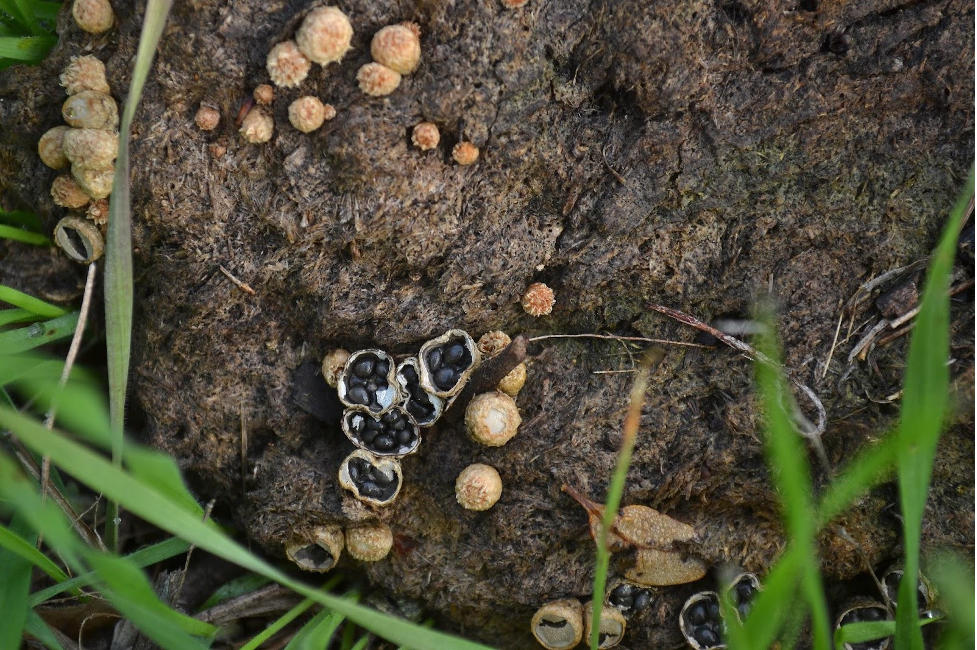
Cultural options:
Protect this year’s plants: Manage plant spacing and greenhouse environmental controls to maximize airflow when possible, but especially in infective conditions (see above) and take other steps to reduce leaf wetness and facilitate rapid drying, such as regular pruning (when appropriate for the crop), avoiding overhead irrigation, scheduling irrigation carefully, etc. Overfertilization with nitrogen can favor excessive canopy density, which in turn can provide ideal humidity conditions for white mold apothecia and ascospore production.
Protect future years’ plants: Crop rotation is of limited usefulness in combating white mold because of this disease’s wide host range, but it does not infect onions, grasses or cereal grains.
Remove and dispose of infected plants as soon as possible, but take care to prevent sclerotia from dropping to the soil whenever feasible. Steps can be taken to reduce survival of sclerotia and inhibit the production of apothecia in areas where it is suspected they entered the soil previously, particularly high-value production areas such as a greenhouse. Soil steaming or solarization (using clear plastic to trap heat in soil) may be effective in killing sclerotia, which are not expected to survive exposure to temperatures above 160 F for 15 to 20 minutes. Critical to this approach is verifying that the necessary temperature has been maintained for a long enough time across the entire soil depth where sclerotia are. In the Northeast, solarization may not be able to produce temperatures necessary to kill sclerotia very far into the soil profile, particularly in the wet and rainy years that white mold tends to be most problematic. If white mold is a new problem for you, and the soil wasn’t disturbed after infected plants were removed, you may only need to heat the top inch of soil. If sclerotia are already known to be present, or newly formed sclerotia have already been tilled into the soil profile, you may need to heat the soil at least to the depth of your tillage. At a bare minimum, treat to a depth of 4 inches — at which point germinating sclerotia are not anticipated to reach the soil surface to release spores, unless brought closer to the surface later on.
In either case, soil steaming and solarization should be implemented before the application of any of the biocontrols listed below, because these methods would also kill any biocontrol organisms.
Another strategy taken by some growers is to either bury sclerotia through inversion tillage (moldboard plowing; not rototilling, which would leave sclerotia spread throughout the soil depth profile) and/or add compost, soil, etc., on top of the area to ensure that sclerotia are too deep for apothecia to reach the soil surface (i.e., at least 4 inches). However, this approach requires careful planning to ensure that future tillage does not bring sclerotia back into the upper 4 inches of the soil for at least eight years.
Organic pesticides (as a last resort):
For home and commercial growers (some products mentioned may not be available to both home and commercial growers):
Several biofungicide products may help to reduce infection from airborne spores. Examples include, but are not limited to, Double Nickel, a bacteria-based fungicide, and BotryStop WP, which consists of the fungus Ulocladium oudemansii. These types of products are intended to work by pre-colonizing aboveground plant surfaces before disease spores can infect, and/or by inducing systemic resistance in plants (i.e., causing them to strengthen their pre-existing defense mechanisms), and as such need to be applied preventatively to have the best chances of being effective.
For commercial growers:
White mold sclerotia are parasitized by the fungus Coniothyrium minitans. This fungus is commercially available as a biofungicide product called Contans. Contans needs to be applied before or after the heat of summer and three to four months prior to planting, and therefore is typically applied via soil incorporation in the early fall. Unfortunately, Contans is frequently only found in package sizes that are larger (and more expensive) than make sense for most farms in the Northeast.
Another group of biofungicide products, such as BIO-TAM and Rootshield, consists of Trichoderma fungus species, which work primarily by colonizing plant roots and protecting them from infection from other fungi, though they may have antagonistic activity against white mold in the soil as well.
Though both Contans and BIO-TAM may reduce apothecia production, and therefore the number of airborne spores present, neither would protect above ground portions of plants from any airborne spores that do reach plants.
Please note: This information is for educational purposes. Any reference to commercial products, trade or brand names is for information only, and no endorsement or approval is intended. Pesticide registration status, approval for use in organic production and other aspects of labeling may change after the date of this writing. It is always best practice to check on a pesticide’s registration status with your state’s board of pesticide control, and for certified organic commercial producers to update their certification specialist if they are planning to use a material that is not already listed on their organic system plan. The use of any pesticide material, even those approved for use in organic production, carries risk — be sure to read and follow all label instructions. The label is the law. Pesticides labeled for home garden use are often not allowed for use in commercial production unless stated as such on the label.
Authors
Written by Caleb Goossen and Mariam Taleb
Source material
Higgins, G. 2016. “White Mold.” UMass Extension Vegetable Program. https://ag.umass.edu/vegetable/fact-sheets/white-mold
Kleczewski, Nathan. 2016. “Sclerotinia vs ‘Birds Nest Fungi.’” University of Delaware Cooperative Extension. https://sites.udel.edu/weeklycropupdate/?p=9523
Sideman, Eric. 2001. “Tomatoes.” MOFGA. https://www.mofga.org/resources/tomatoes/tomatoes/
“White mold on tomatoes.” Cornell College of Agriculture and Life Sciences. https://blogs.cornell.edu/livegpath/gallery/tomato/white-mold-on-tomatoes/

